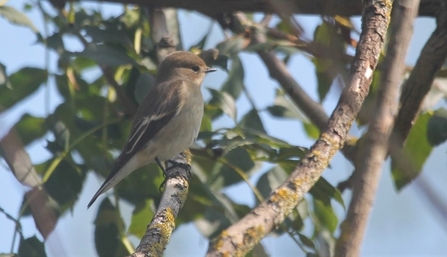
© Chris Farthing
© Chris Farthing

© Chris Farthing
September is another month where migration is the main area of birding interest. We lose the last of our summer visitors, but gain roughly an equal number of winter visitors. Additionally, migrant birds are passing through all month, some for a fleeting overhead glimpse, and some for a few days of feeding up before continuing on their southbound journey.
One of the most remarkable stories of the month was the accumulation of shoveler. Every September sees numbers of shoveler here rise as a moulting flock forms. Over the last five years the flock has tended to be 30-50 birds. This year the flock increased throughout the month, with a high count of 127 being made on the 25th. Given how moulting birds tend to hide away, the real number present was probably somewhere between 150 and 200. Other interest amongst ducks was a female wigeon (picture 1 below) seen on the 7th and small numbers of teal seen all month.
Common snipe and water rail (2) are two birds which are present here all winter but are often difficult to see. The first common snipe was seen on the 19th, with the first water rail, unusually seen before heard, was on the 30th. Kingfisher is another bird which is usually only seen here in the winter, and the first sighting since spring was on the 29th.

© Chris Farthing
In keeping with most of the year so far, our regular raptors, sparrowhawk and peregrine, were supplemented by occasional sightings of both kestrel and hobby. Swifts stayed with us up to the 8th, whereas house martins were seen in good numbers right up to the 28th. A single swallow passed through on the 1st.

© Chris Farthing
At the start of September it is perfectly possible to see eight warbler species here in a day, but by the end of the month three is the most you can hope for. Willow warblers were still regular up to the 19th, with the last sedge warbler seen on the 15th. Four reed warbler sightings were spread through the month, suggesting they were migrant birds passing through rather than our breeding birds still being around. Both lesser whitethroat and common whitethroat were seen on at least three occasions up to the middle of the month.
Nuthatch (3) have had an excellent breeding year in Finsbury Park, and it was expected that post-breeding dispersal would mean that birds would appear here in autumn. One duly arrived on the 8th and was seen around the woodland trail for a couple of days. We are lucky to be amongst the best sites in London to see flycatchers. Pied flycatchers (main picture above) were seen on several occasions, with spotted flycatcher (4) seen fairly frequently, including a bird which stayed in an area just north-east of the main entrance for around a week from the 18th.
Other migrant birds seen or heard passing over in September were meadow pipits (frequently) and siskin (rarely).
The total number of bird species seen here in September was 72, down from the 74 of September 2019 but around the average for the last five years.